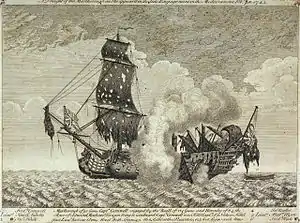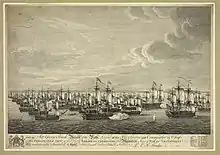HMS St Michael (1669)
HMS St Michael was a 90-gun second rate ship of the line of the Royal Navy, built by John Tippetts of Portsmouth Dockyard and launched in 1669.[1]
 Marlborough after the Battle of Toulon (1744) | |
| History | |
|---|---|
| Name: | HMS St Michael |
| Builder: | Tippetts, Portsmouth Dockyard |
| Launched: | 1669 |
| Renamed: | HMS Marlborough, 1706 |
| Fate: | Wrecked, 29 November 1762 |
| General characteristics as built[1] | |
| Class and type: | 90-gun second rate ship of the line |
| Tons burthen: | 1101 bm |
| Length: | 125 ft (38 m) (keel) |
| Beam: | 40 ft 8 1⁄2 in (12.408 m) |
| Depth of hold: | 17 ft 5 in (5.31 m) |
| Propulsion: | Sails |
| Sail plan: | Full-rigged ship |
| Armament: | 90 guns of various weights of shot |
| General characteristics after 1706 rebuild[2] | |
| Class and type: | 90-gun second rate ship of the line |
| Tons burthen: | 1,579 long tons (1,604.3 t) |
| Length: | 162 ft 8 in (49.58 m) (gundeck) |
| Beam: | 47 ft 4 in (14.43 m) |
| Depth of hold: | 18 ft 6 in (5.64 m) |
| Propulsion: | Sails |
| Sail plan: | Full-rigged ship |
| Armament: | 90 guns of various weights of shot |
| General characteristics after 1732 rebuild[3] | |
| Class and type: | 1719 Establishment 90-gun second rate ship of the line |
| Tons burthen: | 1,567 long tons (1,592.1 t) |
| Length: | 164 ft (50 m) (gundeck) |
| Beam: | 47 ft 2 in (14.38 m) |
| Depth of hold: | 18 ft 10 in (5.74 m) |
| Propulsion: | Sails |
| Sail plan: | Full-rigged ship |
| Armament: | 90 guns: Gundeck: 26 × 32 pdrs Middle gundeck: 26 × 18 pdrs Upper gundeck: 26 × 9 pdrs Quarterdeck: 10 × 6 pdrs Forecastle: 2 × 6 pdrs |
St Michael was rebuilt at Blackwall Yard in 1706, at which time she was also renamed HMS Marlborough.[2] On 5 April 1725 Marlborough was ordered to be taken to pieces and rebuilt at Chatham. She was relaunched on 25 September 1732.[3]
On 11 February 1744 during the Battle of Toulon. Marlborough and Namur bore the brunt of the Spanish fire, her captain James Cornewall, and 42 crew were killed and 120 wounded out of her crew of 750 men.[4] Command passed to his distant cousin, Frederick Cornewall, the First Lieutenant, who was severely wounded and lost his right arm. Cornewall was buried at sea.
Marlborough was reduced to a 68-gun ship in 1752.[3]

She formed part of Sir George Pocock's fleet at the taking of Havana from the Spanish in 1762. Whilst making her way back to Britain she was caught in very heavy weather, and on 29 November 1762 her crew were forced to abandon ship, all of her crew being taken off by a passing HMS Antelope before she sank.[5] Her Captain Thomas Burnett was court martialled as a result, and although exonerated would not regain a command till 1770.[6]
Notes
- Lavery, The Ship of the Line vol.1, p161.
- Lavery, The Ship of the Line vol.1, p166.
- Lavery, The Ship of the Line vol.1, p169.
- Mathews, Thomas (1744). Narrative of the Proceedings of his Majesty's Fleet in the Mediterranean (3rd ed.). London. p. 118.
- Ships of the Old Navy, Marlborough.
- https://ore.exeter.ac.uk/repository/bitstream/handle/10036/120046/McLeodA.pdf?sequence=1
References
- Lavery, Brian (2003) The Ship of the Line - Volume 1: The development of the battlefleet 1650-1850. Conway Maritime Press. ISBN 0-85177-252-8.
- Michael Phillips. Marlborough (96) (1706). Michael Phillips' Ships of the Old Navy. Retrieved 6 December 2007.